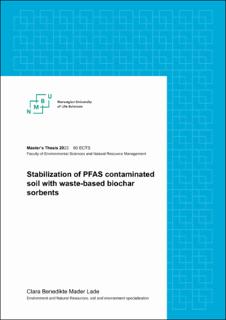| dc.description.abstract | The widespread use of per- and polyfluoroalkyl substances (PFAS) for decades has caused worldwide soil- and groundwater contamination, due to their mobility and persistency. Few existing technologies are suitable for PFAS remediation, hence a great need has arisen for new remediation technologies for PFAS impacted sites. Biochar is a carbonaceous material produced by heating biomass in absence of oxygen and has in recent years increasingly been investigated for PFAS adsorption in both water and soil. In addition to stabilization of contaminants, biochar also contributes to climate change mitigation by locking up carbon from rapidly decomposing biomass, thereby reducing potential emissions of CO2 to the atmosphere. The use of waste as the biomass for biochar production can further contribute to the transition into a more circular economy.
In this study, the effects of different waste-based biochars on sorption of PFAS in soil, was investigated through up-flow column percolation tests. A sandy soil with 0.57 ± 0.04% TOC, originating from a former firefighting training facility in the Oslo region was used. The soil was contaminated with aqueous film forming foam (AFFF), containing mainly perfluorooctanesulfonic acid (PFOS), and was packed in columns with 1% (w/w) biochar. The experiment tested 6 different types of biochar, produced from the following 5 feedstocks: clean wood chip pellets (CWC), digested sewage sludge from two different WWTPs (DSS-1 and DSS-2), dewatered raw sewage sludge (DWSS) and waste timber (WT, activated and non-activated). As sludge often is contaminated with e.g., PFAS, handling and disposal can therefore be problematic. Using sludge in the production of biochar, instead of landfilling or incineration, can thus provide a more sustainable solution, as PFAS concentrations have been shown to be significantly reduced after pyrolysis. PFAS analyses were carried out for soil from the columns, for the original soil, and for leachate samples from each column collected at different liquid to solid ratios (L/S).
PFOS leaching was reduced in all columns amended with biochar, compared to the control column. The activated WT biochar and the three sewage sludge-based biochars (DSS-1, DSS-2, DWSS) proved to be better sorbents for PFAS originating from the AFFF contaminated soil, than the two non-activated wood-based sorbents (CWC and WT). The leaching of PFOS by biochar amendment was reduced in the following order: aWT (99.9%) > DWSS (98.9 ± 0.24%) > DSS-2 (97.8%) > DSS-1 (91.6%) >> CWC (42.4 ± 5.1%) > WT (33.7%). Distribution coefficients for PFAS sorption to biochar (log Kd, L/kg) showed similar trends and were highest for sorption to the aWT (e.g., log Kd PFOS = 5.09 L/kg). In addition, the four best sorbents also showed reductions of dissolved organic carbon (DOC) concentrations in the leachate. Evaluation of possible DOC-facilitated transport of PFAS in the aqueous phase led to the conclusion of DOC concentrations having a significant effect on PFAS concentrations in the leachate, for PFAS with CF-chains shorter than 8. Stronger PFAS sorption was seen with longer CF-chain lengths. The higher sorption strength of the aWT and the sludge-based biochars, were explained by larger pore diameters (> 0.7 nm) which were able to accommodate the detected PFAS with maximum molecular diameters of 1.02 - 2.2 nm, whereas the majority of the pores in CWC and WT were too small to accommodate PFAS.
This is the first ex-situ column study to show that waste/sludge-based biochars can be an effective alternative to e.g. fossil based activated carbon for remediation of PFAS contaminated soil. Furthermore, the application of waste-based sorbents for cleaning of contaminated soil, contributes to circular economy, by utilizing waste fractions as a resource, reducing the content of contaminants in the biochar after pyrolysis, and stabilizing contaminants in soil, in addition to sequestering carbon. A special case of this was the very effective treatment of PFAS contaminated soil by amendment with the DWSS biochar, which was made from sewage sludge contaminated with PFAS originating from the same firefighting training facility as the soil. | |
